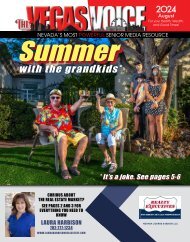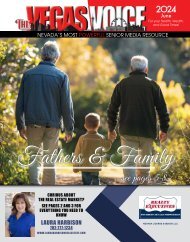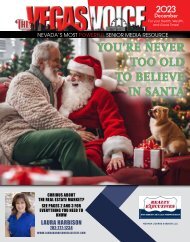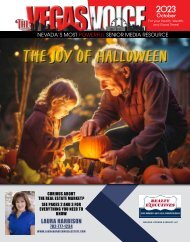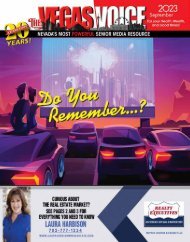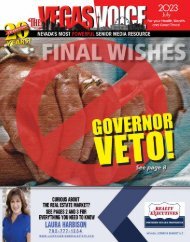Create successful ePaper yourself
Turn your PDF publications into a flip-book with our unique Google optimized e-Paper software.
genealogy:<br />
32<br />
Time to Get Organized<br />
By: Craig Smith / Exploring Your Roots<br />
It’s time to make those New Years resolutions.<br />
Organizing your genealogy research at the<br />
beginning of the new year is a great idea to start<br />
afresh and make your research more efficient.<br />
Here are some tips to help you organize your<br />
Create a Research<br />
Plan:<br />
1. Outline a research<br />
plan for the year. Identify<br />
specific goals and the<br />
steps needed to achieve<br />
them.<br />
2. Break down larger<br />
goals into manageable tasks to stay focused.<br />
3. Prioritize your research objectives and focus on specific branches<br />
or individuals.<br />
Collaborate & Share:<br />
1. Connect with other researchers or family members to share<br />
information.<br />
2. Collaborate on research projects and consider joining genealogy<br />
forums or online communities.<br />
Educate Yourself:<br />
1. Stay updated on new genealogy research methods, tools, and<br />
resources.<br />
2. Attend genealogy conferences, webinars, or workshops to enhance<br />
your skills.<br />
Organize Physical Records:<br />
1. If you have physical documents or photos, organize them in a<br />
systematic way.<br />
2. Consider digitizing important documents to ensure their<br />
preservation.<br />
The key to successful genealogy research is consistency and attention<br />
to detail. By organizing your genealogy at the beginning of the year, you<br />
set yourself up for a more productive and enjoyable research experience.<br />
For those new to genealogy, consider joining a local genealogical<br />
society. For example, the Clark County Nevada Genealogical Society,<br />
in partnership with Henderson Libraries, offers numerous classes and<br />
research opportunities.<br />
In addition to monthly meetings with guest speakers on a variety of<br />
topics, the Society is offering a “Beginning Genealogy” course on February<br />
22, 2024 at the Paseo Verde Library. This class offers the beginning<br />
researcher an opportunity to learn from experienced genealogists.<br />
Paseo Verde Library also has the “Heritage Research Room” that<br />
is dedicated to genealogy research. Many days of the week there are<br />
volunteers available to assist you with your research.<br />
Craig Smith is the President of the Clark County Nevada<br />
Genealogical Society. The Society meets on the third Saturday of<br />
each month at the Paseo Verde Library in Henderson. Craig can<br />
be contacted at president@ccngs.org<br />
January 2024<br />
Prescott Offers Arizona<br />
History Capsule<br />
By: Kathy Manney / Around Our World<br />
Beneath the expansive canopies of more than<br />
100-year-old trees lies the Sharlot Hall Museum,<br />
a history capsule museum of exhibits and former governor homes dating<br />
to Arizona’s territorial days. The museum holds considerable amounts of<br />
Prescott’s territorial history and additionally maintains the Museum of<br />
Indigenous People.<br />
Prescott became Arizona’s Territory capitol in 1864. One hundred<br />
years later, when Barry Goldwater became the 1964 Republican nominee<br />
for president, he launched his presidential campaign from the steps of<br />
Prescott’s Yavapai County Courthouse.<br />
The capital moved<br />
from Prescott to Tucson<br />
in 1867 and then<br />
returned to Prescott in<br />
1877, finally settling<br />
on Phoenix as the<br />
permanent capital<br />
in 1889. The three<br />
Arizona Territory<br />
capitals reflect<br />
political changes of<br />
those territory regions<br />
as they grew and<br />
developed.<br />
Prescott was a boisterous town, handing down a rich history. Many<br />
times, the rough-and-ready wooden town burned to the ground.<br />
Doc Holliday and Virgil Earp of the gunfight at the O.K. Corral once<br />
lived here. Virgil Earp, a Prescott constable in 1878 and Doc Holliday<br />
appears in the 1880 census records.<br />
The Yavapai, who split from Patayan groups in about 1300 A.D., are<br />
considered the original indigenous inhabits. The first recorded European<br />
contact with the Yavapai was in 1583, when the Spanish came searching<br />
for gold.<br />
Permanent European presence started with gold discovery south of<br />
Prescott in 1863 and soon gold was found in other nearby locations.<br />
Settlers quickly arrived for the mining, often clashing with the indigenous<br />
tribes. Their skirmishes caused neighboring Fort Whipple to struggle in<br />
being territory peace keeper.<br />
Prescott grew into northern Arizona’s most important city because<br />
the areas mineral wealth was of such high-quality. The gold quality<br />
also aided the escalating American Indian Wars, as settlers and natives<br />
increasingly displayed aggression toward one another.<br />
Present day Prescott is known for their self-proclaiming “World’s<br />
Oldest Rodeo” having run continuously since 1888 and brings thousands<br />
of rodeo fans as tourism augments the economy.<br />
Kathy draws her articles from a diverse personal background. She<br />
hopes readers enjoy her column as much as she enjoys the writing and<br />
sharing.



